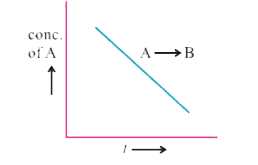Complete Solutions to SHORT ANSWER-I TYPE QUESTIONS of chapter CHEMICAL KINETICS of Class 12 book with complete answers and questions
| Class 12 | CHEMISTRY |
| Chapter | CHEMICAL KINETICS |
| SUPPORT MATERIAL | SHORT ANSWER-I TYPE QUESTIONS |
| Number Of Questions | 26 |
| Academic Year | 2023-24 |
The rate of a particular reaction quadruples when the temperature changes from 293 K to 313 K. Calculate activation energy in KJ/mol.
View SolutionIf the decomposition of nitrogen oxide as `2N_2O_5 to 4NO_2 + O_2` follows a first order kinetics .
Calculate the rate constant for a 0.05M solution if the instantaneous rate is `1.5 xx10^(−6)` mol/l/s ?
View SolutionIf the decomposition of nitrogen oxide as `2N_2O_5 to 4NO_2 + O_2` follows a first order kinetics. K=3.0 × 10^(-5) sec^(-1) .
What concentration of `N_2O_5` would give a rate of `2.45 xx 10^(−5) "mol L"^(-1) s^(-1)` ?
View SolutionWrite the difference between order and molecularity of reaction.
View SolutionConsider the decomposition reaction :
`2H_2O_2 overset(OH^(-)//I^-)to 2H_2O + O_2`
This reaction takes place in two steps as given below :
Step 1. `H_2O_2 + I^(-) to H_2O + IO^(-)` (slow)
Step 2. `H_2O_2 +IO^(-) to H_2O + I^(-) + O_2` (fast)
Determine rate law expression.
View SolutionConsider the decomposition reaction :
`2H_2O_2 overset(OH^(-)//I^-)to 2H_2O + O_2`
This reaction takes place in two steps as given below :
Step 1. `H_2O_2 + I^(-) to H_2O + IO^(-)` (slow)
Step 2. `H_2O_2 +IO^(-) to H_2O + I^(-) + O_2` (fast)
Determine the order of reaction.
View SolutionThe decomposition of hydrocarbon follows the equation `k=(4.5xx10^(11)s^(-1))e^(-28000K//T)`
Calculate `E_(a)`.
View SolutionA reaction is of second order with respect to a reactant. How is the rate of reaction affected if the concentration of the reactant is reduced to half ? What is the unit of rate constant of such a reaction ?
View SolutionFor a first order reaction, time taken for half of the reaction to complete is `t_(1)and 3/4` of the reaction to complete is `t_(2)`. How are `t_(1)and t_(2) related?
View Solution
What is the order of the reaction ?
View Solution
What is the slope of the curve ?
View SolutionDerive an expression to calculate time required for completion of zero order reaction.
View SolutionFor the reaction`N_2 (g) + 3H_2 (g) to 2NH_3 (g)`
How is the rate of formation of ammonia related to the rate of disappearance of `H_2` ?
View SolutionThe rate of a gaseous reaction is halved when the volume of the vessel is doubled. What is the order of reaction ?
View SolutionA reaction which is first order with respect to A has rate constant `6 "min"^(-1)`. If we start with `[A] = 0.5 "mol L"^(-1)`, when would [A] reach the value of 0.05 `ML^(-1)` ?
View SolutionThe conversion of the molecules X to Y follows second order kinetics. If the concentration of X is increased to three times, how will it affect the rate of formation of Y ?
View SolutionA first order reaction has a rate constant of `1.15xx10^(-3) s^(-1)`. How long will 5 g of this reactant take to reduce to 3 g ?
View Solution`4NH_3 + 5O_2 to 4NO + 6H_2O`. If rate of formation of NO is `6 xx 10^(−4) "atm min"^(-1)`, calculate the rate of formation of `H_2O`.
View SolutionConsider a certain reaction `A rarr` Products with `k=2.0xx10^(-2)s^(-1)`. Calculate the concentration of `A` remaining after `100s` if the initial concentration of `A` is `1.0 mol L^(-1)`.
View SolutionExplain with an example, what is a pseudo first order raction ? The graphs (A and B) given below are plots of rate of reaction Vs concentration of the reactant. Predict the order from the graphs.
View SolutionDifferentiate between :Average rate and instantaneous rate of a chemical reaction.
View SolutionDifferentiate between :Molecularity and order of reaction.
View SolutionShow that in case of a first order reaction, the time required for `99.9%` of the reaction to take place is about `10` times that the required for half the reaction.
View SolutionFor the reaction `NO_2 + CO to CO_2 + NO`, the experimentally determined rate expression below 400 K is rate = `k[NO_2]^2`. What mechanism can be proposed for this reaction ?
View SolutionThe half life period of a first order reaction is 60 min. What percentage will be left after 240 min.
View SolutionTime for half change for a first order reaction is 25 min. What time will be required for 99% reaction ?
View Solution
SHORT ANSWER-I TYPE QUESTIONS questions and complete solutions for chapter CHEMICAL KINETICS of CBSE COMPLEMENTARY MATERIAL CHEMISTRY (HINGLISH) of Class 12